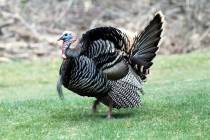Inline muzzleloader isn’t your grandpa’s hunting rifle
Just as the argument is heating up over whether Nevada should legalize rifle scopes for use during muzzleloader-only hunting seasons, the company that turned the muzzleloading world upside-down with its Knight Rifle has closed its doors.
Modern Muzzleloading, Inc. pulled the plug on its Knight Rifles Division on June 30, citing an overall industry downturn as the primary reason. So where does that leave product distributors, retail outlets and those who purchased a Knight for hunting or target shooting?
In a written statement, the company has assured its wholesale and retail customers that it will continue to provide customer service.
"All warranty, nonwarranty and replacement part services will remain in place ... and all customers will have access to experienced personnel for consultation, questions and repair of Knight products," the statement read.
Customers still will be able to buy parts and accessories through Modern Muzzleloading.
The original Knight Rifle, the MK-85, came onto the scene in 1985. It was the first muzzleloader of the modern era to use an inline system for igniting the powder charge. The rifle's inventor, Tony Knight, named the gun after his daughter, Michelle. And the muzzleloading industry soon named Knight the father of modern muzzleloading. Probably because it wasn't long before all the major manufacturers of muzzleloading firearms -- including Thompson Center, Traditions, Connecticut Valley Arms and even Remington -- designed and produced their versions of what the industry calls an "inline."
Basically, the concept behind Knight's inline ignition system was to provide a short, direct route for a spark to travel from a percussion cap to the powder charge at the bottom of the rifle's barrel.
At the time, muzzleloading enthusiasts carried rifles like the Hawken or the Kentucky Long Rifle, something you might see when watching a movie about Daniel Boone. These firearms use either a flint or a percussion cap to create a spark. That spark has to travel sideways through a small channel called the flash hole to reach the powder charge. As one might imagine, this system doesn't always work.
By adding a nipple that accepted a 209 shotgun primer rather than the No. 11 percussion cap used on traditional muzzleloaders, Knight created a rifle that fired consistently without the challenges associated with a flintlock or caplock mechanism. He added a barrel with a 1-in-28 rate of twist for accuracy and distance. Then, to top off the package, Knight put everything on a stock that looked and felt like a modern bolt-action rifle.
When hunters learned they could shoot a front stuffer that was more accurate over longer distances than a traditional muzzleloader, one that fired consistently and felt like a modern rifle in their hands, it didn't take them long to find a way to buy one. This was especially true among hunters who wouldn't give muzzleloading so much as a legitimate thought before Knight's rifle hit the market.
While the Knight Rifle launched a surge in muzzleloader sales, it also sparked intense debate over the legitimacy of an inline and whether a rifle fitting that description could be classified as a muzzleloading firearm. Many of those who had been hunting with a flintlock or a caplock rifle before the Knight Rifle's introduction found the new-fangled contraption to be an abomination and movements began to make them illegal during muzzleloader-only hunting seasons. But that movement never got much traction.
My views on inline muzzleloaders have tempered over the years, but I do get concerned when I hear people talking about taking unethically long shots at deer or other game with their inline. By their nature, muzzleloaders of any design can be temperamental, especially in the field. Just because the marketing materials that came with the rifle say you can, it doesn't mean you should. Inline rifles may look like your .300 Winchester Magnum, but they won't shoot like it.
• ANTELOPE SEMINAR -- The Nevada Department of Wildlife will host a seminar for hunters who would like to learn more about hunting pronghorn antelope. The seminar is scheduled from 6 to 9 p.m. Wednesday in the commission chambers of the Clark County Government Center, 500 Grand Central Parkway.
Topics will include the antelope's habitats and behavior as well as game care in the field.
For more information, call 486-5127, ext. 3501.
Freelance writer Doug Nielsen is a conservation educator for the Nevada Department of Wildlife. His "In the Outdoors" column, published Thursday in the Las Vegas Review-Journal, is not affiliated with or endorsed by the NDOW. Any opinions he states in his column are his own. He can be reached at dougnielsen@att.net.

















